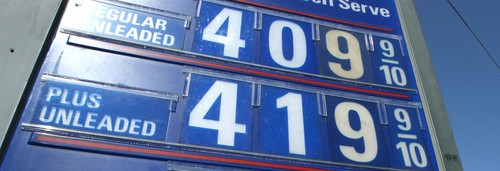Despite skyrocketing gas prices, oil shale remains long-term energy prospect on Colorado's Western Slope
Observers of the century-long quest to extract oil from the shale rocks of Colorado's Western Slope are fond of saying “oil shale is the fuel of the future … and always will be.” Never commercially viable because of the costs and resources needed to heat and extract the kerogen trapped in the rocks, an estimated 2 trillion barrels of shale oil remains locked up – perhaps forever.
But why then has Shell spent an estimated $200 million so far on research, development and demonstration (RD&D) at its Mahogany Research Project in western Colorado? And at what point will gas prices rise so high that the cost of producing shale oil suddenly makes sense?
“All of the major companies are doing oil shale because they think it's an interesting and high-potential area, but they're not in a hurry to make it productive,” said Jeremy Boak, director of the Center for Oil Shale Technology and Research (COSTAR) at the Colorado School of Mines in Golden. COSTAR's research is described on its website as “industry-driven and science-guided.”
“With [oil] prices going back up through the roof again,” Boak said, “[companies have] an awful lot of things to spend their money on and some of them more near-term than oil shale. The big budgets tend to move toward things that are a little closer in.” Still, Boak maintains the state and federal governments should be doing far more to encourage oil shale production than the current administrations. The OPEC oil embargo during the Yom Kippur War saw gas prices in the United States spike from 38 cents a gallon in 1973 to 55 cents a gallon in 1974, in part prompting an oil shale boom in Colorado that culminated in the “Black Sunday” crash of 1982. Exxon literally pulled up stakes overnight and turned communities like Parachute, Rifle and Battlement Mesa into ghost towns.
The OPEC oil embargo during the Yom Kippur War saw gas prices in the United States spike from 38 cents a gallon in 1973 to 55 cents a gallon in 1974, in part prompting an oil shale boom in Colorado that culminated in the “Black Sunday” crash of 1982. Exxon literally pulled up stakes overnight and turned communities like Parachute, Rifle and Battlement Mesa into ghost towns.
Exxon is one of the companies pursuing a more scaled-back RD&D lease being offered by the Obama administration, which announced in February it was taking a “fresh look” at the Bush administration's so-called “midnight regulations” in 2008 that established a royalty structure and opened up 2 million acres of U.S. Bureau of Land Management land in Colorado, Utah and Wyoming for potential oil shale leasing.
“The previous 2008 regulations made critical decisions such as royalty rate before the RD&D program had a chance to deliver information and answers,” U.S. Interior Secretary and former Colorado Sen. Ken Salazar said in February. “They put the cart before the horse, and in so doing they heightened the risk of speculation and bad decisions and yet another oil shale bust.”
But Exxon officials say they're keenly aware of past mistakes and determined not to repeat them.
“It sounds to me like there was a lot more hype back then, but it's always hard to tell where the hype came from,” Boak said. “Was it really the companies that were hyping it or was it the people out there who thought they could buy 5,000 acres and make a killing? Land speculators. Was it the large corporations or was it the Bernie Madoffs of their era that were really trying to cash in on this?”
Ramped up in the late 70s with the embargo fresh in everyone's minds, oil shale crashed once Middle East oil began flowing freely and the labor-intensive process of surface mining and retorting oil shale was no longer cost-effective. But 30 years later oil prices are skyrocketing again in the wake of ongoing political upheaval in the Middle East and Northern Africa.
The U.S. Energy Information Administration on Monday put the average price for a gallon of regular gasoline at $3.79, closing in on the peak of $4.11 a gallon set on July 17, 2008. In Europe, gasoline broke the $8.60 a gallon barrier this spring as events unfolded in Tunisia, Egypt and Libya.
But even at those prices, commercial oil shale production is of limited interest to Europeans. While still part of the Soviet Union, Estonia developed a commercial oil shale industry, but there have been growing environmental concerns since that nation became part of the European Union.
Boak says companies in Estonia, Brazil and China continue to blaze the oil shale trail, with one Estonian firm “hunting for properties” appropriate for oil shale development in the United States. Still, none of the foreign firms have been able to produce much more than a few thousand barrels of oil a day – a drop in the bucket in terms of global demand. And now the European Union is considering banning oil shale and tar sands development because of studies showing higher greenhouse gas emissions than from conventional fuels.
Meanwhile, Republican members of Colorado's congressional delegation continue to beat the oil shale drum. Just last month in a guest column in the Grand Junction Daily Sentinel, 3rd Congressional District Rep. Scott Tipton wrote: “The development of [oil shale] resources would lead to tens of thousands of good paying jobs and help stabilize our energy supply – putting an end to spikes in gas prices.”
Juxtapose that statement with what Tom Yelverton of ExxonMobil told the Daily Sentinel late last year: “At best, commercial production is a decade away and most likely more.”
Rep. Doug Lamborn of Colorado's 4th Congressional District is a big backer of stepping up domestic oil and gas production, including oil shale, on the state's Western Slope.
“It is all well and good to propose measures that may pay off decades in the future, such as alternative energy research and higher CAFÉ standards for vehicles,” Lamborn states on his website. “The most urgent and immediate solution though is to ramp up domestic production of oil and gas right now.”
Even the companies deeply involved on oil shale research say it's years from becoming a commercial reality: “In fact, it could take up to 10 to 12 years of additional research, environmental analysis and permitting before a company could develop a federal oil shale lease,” Tracy Boyd of Shell told the Glenwood Post Independent in late 2008.
But why then has Shell spent an estimated $200 million so far on research, development and demonstration (RD&D) at its Mahogany Research Project in western Colorado? And at what point will gas prices rise so high that the cost of producing shale oil suddenly makes sense?
“All of the major companies are doing oil shale because they think it's an interesting and high-potential area, but they're not in a hurry to make it productive,” said Jeremy Boak, director of the Center for Oil Shale Technology and Research (COSTAR) at the Colorado School of Mines in Golden. COSTAR's research is described on its website as “industry-driven and science-guided.”
“With [oil] prices going back up through the roof again,” Boak said, “[companies have] an awful lot of things to spend their money on and some of them more near-term than oil shale. The big budgets tend to move toward things that are a little closer in.” Still, Boak maintains the state and federal governments should be doing far more to encourage oil shale production than the current administrations.

Exxon is one of the companies pursuing a more scaled-back RD&D lease being offered by the Obama administration, which announced in February it was taking a “fresh look” at the Bush administration's so-called “midnight regulations” in 2008 that established a royalty structure and opened up 2 million acres of U.S. Bureau of Land Management land in Colorado, Utah and Wyoming for potential oil shale leasing.
“The previous 2008 regulations made critical decisions such as royalty rate before the RD&D program had a chance to deliver information and answers,” U.S. Interior Secretary and former Colorado Sen. Ken Salazar said in February. “They put the cart before the horse, and in so doing they heightened the risk of speculation and bad decisions and yet another oil shale bust.”
But Exxon officials say they're keenly aware of past mistakes and determined not to repeat them.
“It sounds to me like there was a lot more hype back then, but it's always hard to tell where the hype came from,” Boak said. “Was it really the companies that were hyping it or was it the people out there who thought they could buy 5,000 acres and make a killing? Land speculators. Was it the large corporations or was it the Bernie Madoffs of their era that were really trying to cash in on this?”
Ramped up in the late 70s with the embargo fresh in everyone's minds, oil shale crashed once Middle East oil began flowing freely and the labor-intensive process of surface mining and retorting oil shale was no longer cost-effective. But 30 years later oil prices are skyrocketing again in the wake of ongoing political upheaval in the Middle East and Northern Africa.
The U.S. Energy Information Administration on Monday put the average price for a gallon of regular gasoline at $3.79, closing in on the peak of $4.11 a gallon set on July 17, 2008. In Europe, gasoline broke the $8.60 a gallon barrier this spring as events unfolded in Tunisia, Egypt and Libya.
But even at those prices, commercial oil shale production is of limited interest to Europeans. While still part of the Soviet Union, Estonia developed a commercial oil shale industry, but there have been growing environmental concerns since that nation became part of the European Union.
Boak says companies in Estonia, Brazil and China continue to blaze the oil shale trail, with one Estonian firm “hunting for properties” appropriate for oil shale development in the United States. Still, none of the foreign firms have been able to produce much more than a few thousand barrels of oil a day – a drop in the bucket in terms of global demand. And now the European Union is considering banning oil shale and tar sands development because of studies showing higher greenhouse gas emissions than from conventional fuels.
Meanwhile, Republican members of Colorado's congressional delegation continue to beat the oil shale drum. Just last month in a guest column in the Grand Junction Daily Sentinel, 3rd Congressional District Rep. Scott Tipton wrote: “The development of [oil shale] resources would lead to tens of thousands of good paying jobs and help stabilize our energy supply – putting an end to spikes in gas prices.”
Juxtapose that statement with what Tom Yelverton of ExxonMobil told the Daily Sentinel late last year: “At best, commercial production is a decade away and most likely more.”
Rep. Doug Lamborn of Colorado's 4th Congressional District is a big backer of stepping up domestic oil and gas production, including oil shale, on the state's Western Slope.
“It is all well and good to propose measures that may pay off decades in the future, such as alternative energy research and higher CAFÉ standards for vehicles,” Lamborn states on his website. “The most urgent and immediate solution though is to ramp up domestic production of oil and gas right now.”
Even the companies deeply involved on oil shale research say it's years from becoming a commercial reality: “In fact, it could take up to 10 to 12 years of additional research, environmental analysis and permitting before a company could develop a federal oil shale lease,” Tracy Boyd of Shell told the Glenwood Post Independent in late 2008.
![]() 0 Comments on "Despite skyrocketing gas prices, oil shale remains long-term energy prospect on Colorado's Western Slope"
0 Comments on "Despite skyrocketing gas prices, oil shale remains long-term energy prospect on Colorado's Western Slope"
Be the first to comment below.


 Vail Town Council to weigh new plan to redevelop T...
Vail Town Council to weigh new plan to redevelop T...  All about indexes
All about indexes  Transforming your social security into a winning r...
Transforming your social security into a winning r...  Pass sales, real estate transactions, revenues inc...
Pass sales, real estate transactions, revenues inc...  Vail Valley native with passion for Biophilic inte...
Vail Valley native with passion for Biophilic inte...  Beaver Creek starts work on new summer activities
Beaver Creek starts work on new summer activities  Land Trust, ECO Trails, Vail Resorts team up to cl...
Land Trust, ECO Trails, Vail Resorts team up to cl...  EUROVISION named Host Broadcaster for 2015 World A...
EUROVISION named Host Broadcaster for 2015 World A...  Vail Resorts brings back Lindsey Vonn's 'School of...
Vail Resorts brings back Lindsey Vonn's 'School of...  Hundreds turn out for 2015 World Championships vol...
Hundreds turn out for 2015 World Championships vol...  Eagle County Senior Health Expo and 9th Annual Hea...
Eagle County Senior Health Expo and 9th Annual Hea...  Final race of Vail Mountain Trail Running Series s...
Final race of Vail Mountain Trail Running Series s...  Before you write your will ...
Before you write your will ...  2015 World Ski Championships volunteer recruitment...
2015 World Ski Championships volunteer recruitment...  Ascent Sotheby’s International Realty in Vail an...
Ascent Sotheby’s International Realty in Vail an...  CDOT outlines road closures for local stages of US...
CDOT outlines road closures for local stages of US...  Italian artist creates unique trophies for Vail, B...
Italian artist creates unique trophies for Vail, B...  Vail Recreation District once again hosting Jake W...
Vail Recreation District once again hosting Jake W... 

